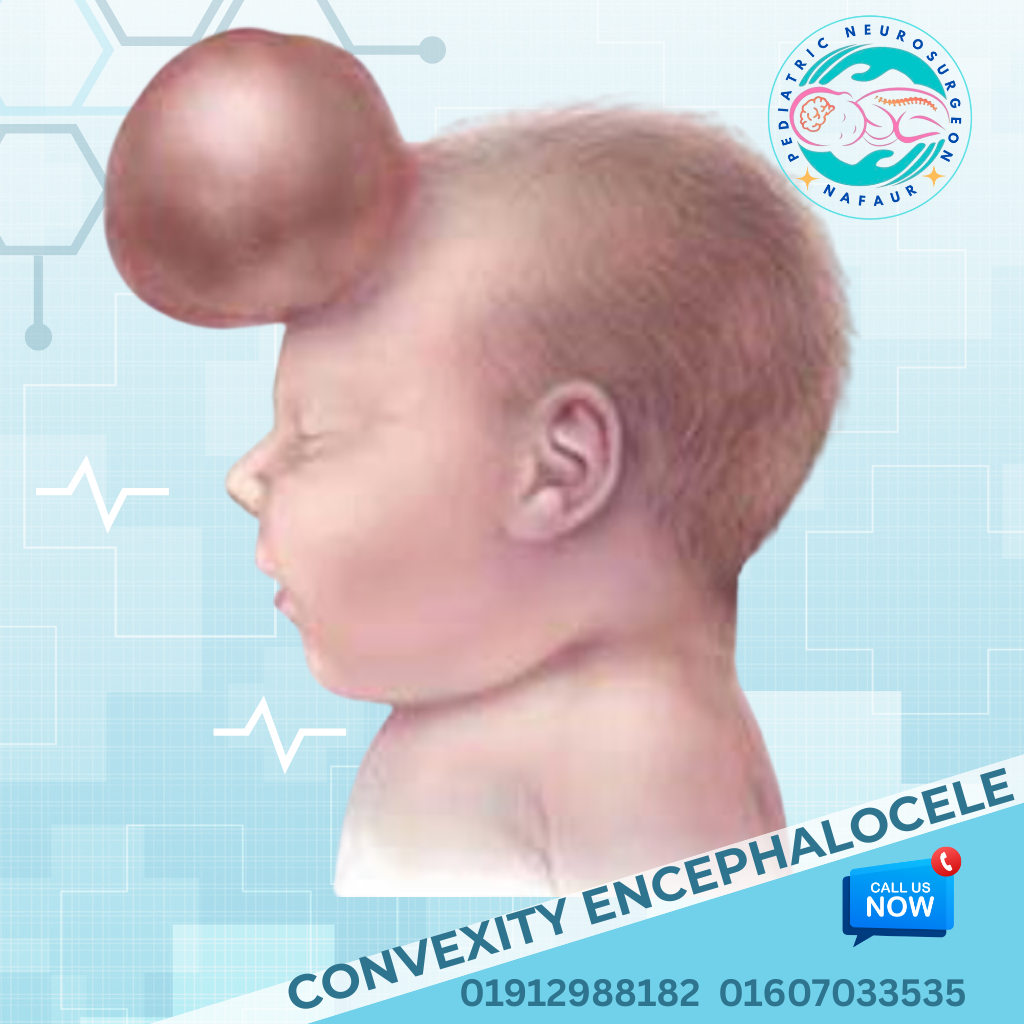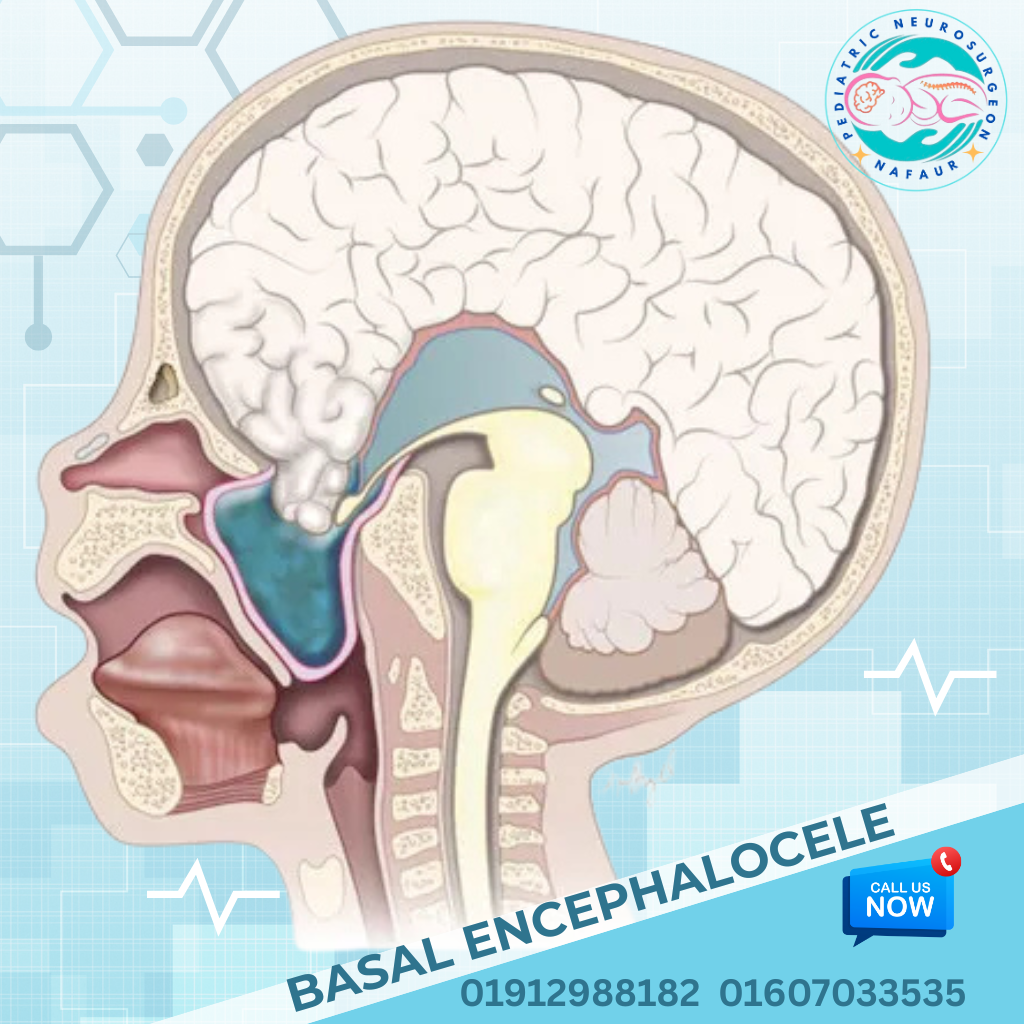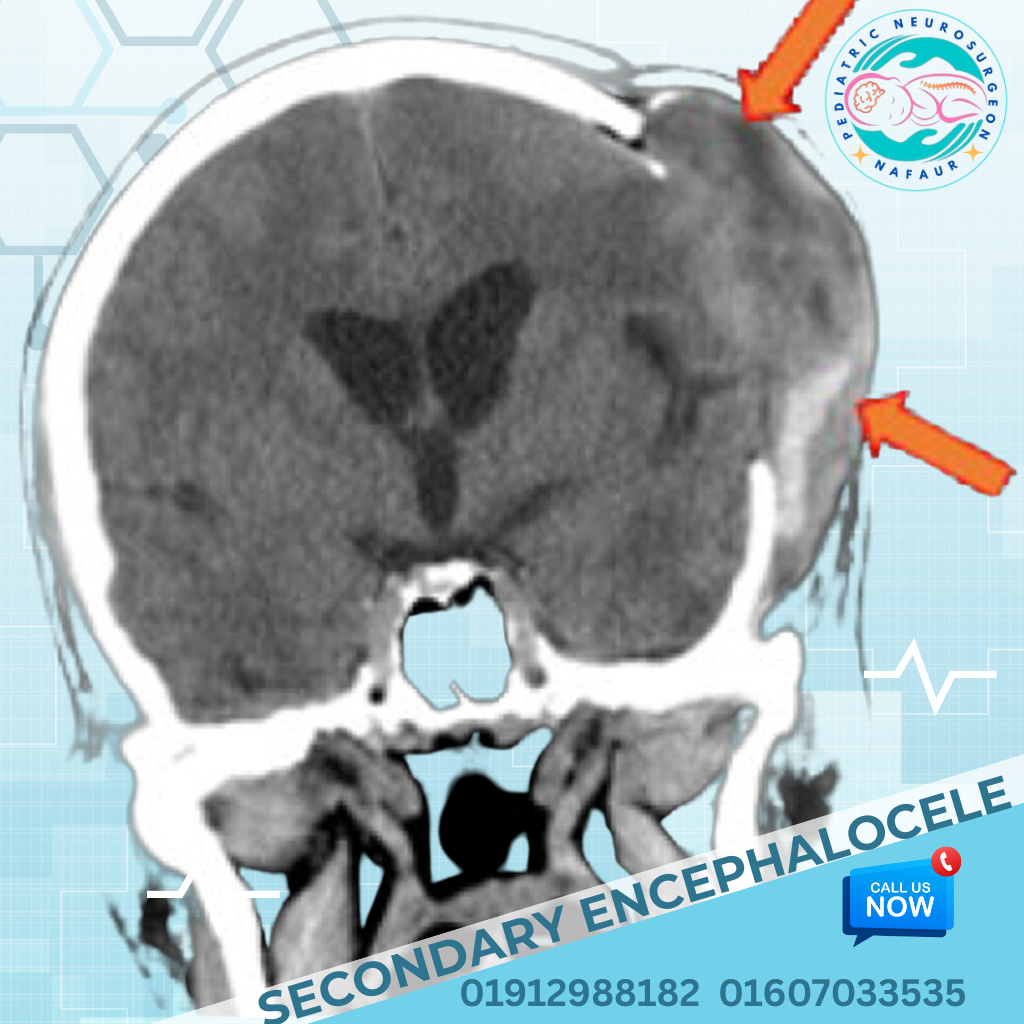Encephalocele
Encephalocele is a serious congenital (birth) defect in which a portion of the brain and its surrounding membranes (meninges) protrude through an abnormal opening in the skull. This sac-like protrusion is most commonly seen on the back of the head (occipital encephalocele), but may also appear on the front or top of the skull. It is a type of neural tube defect (NTD).
In Bangladesh, encephalocele is often seen in rural or underserved communities due to lack of prenatal care, folic acid deficiency during pregnancy, and delayed medical intervention after birth. Without proper neurosurgical treatment, children may face severe neurological deficits, infections, or early death.
 Encephalocele in Bangladesh – A Public Health Challenge
Encephalocele cases are not uncommon in Bangladesh, especially in:
Rural and remote districts
Families with poor antenatal screening
Mothers with inadequate nutrition or health education
Areas with limited access to advanced pediatric neurosurgical services
Many families delay treatment, relying on home remedies or local healers, leading to infection, rupture, or irreversible brain damage.
Dr. Md. Nafaur Rahman, one of Bangladesh’s leading pediatric neurosurgeons, offers state-of-the-art surgical correction and postoperative care for encephalocele at both NINS and the Bangladesh Paediatric Neurocare Centre.
👶 Common Types of Encephalocele
Occipital Encephalocele: Protrusion at the back of the head – most common in Bangladesh
Frontal (Nasoethmoidal or Naso-orbital): Rare, but involves the front of the skull and facial bones
Parietal Encephalocele: Seen at the top of the skull
Basal Encephalocele: Hidden within the nasal cavity or behind the eyes (diagnosed via imaging)
⚠️ Signs and Symptoms
Depending on size and brain involvement, symptoms include:
Visible swelling or sac on the head, often pulsating
Seizures or abnormal movements
Difficulty feeding or developmental delay
Weakness, paralysis, or limb abnormalities
Vision or hearing impairment (in frontally located lesions)
CSF leakage, recurrent infections (especially if ruptured)
🧪 Diagnosis
Early and accurate diagnosis is essential. This includes:
Antenatal ultrasonography – often missed in rural settings
Postnatal CT scan or MRI – to assess brain content and bony defect
Neurological examination to determine functional prognosis
Dr. Nafaur emphasizes the importance of prenatal folic acid supplementation and antenatal ultrasound screening to reduce encephalocele incidence in Bangladesh.
🛠️ Surgical Treatment of Encephalocele
Surgical intervention is the only definitive treatment and should be done as early as possible. Key goals of surgery include:
Removal of non-functional brain tissue in the sac
Repairing the skull defect to prevent further brain herniation
Ensuring a watertight closure to prevent CSF leakage and infection
Cosmetic reconstruction (especially for frontal encephaloceles)
🧠 Timing of Surgery
Ideally within first few months of life
Emergency surgery if sac is leaking CSF, infected, or ruptured
🔬 Advanced Surgical Techniques by Dr. Nafaur
Microsurgical closure of dura and bone
Image-guided planning for large or complex defects
Plastic surgery collaboration for cosmetic facial repair (if needed)
Shunt placement if hydrocephalus is associated
“Even large encephaloceles can be treated successfully with timely surgery. Early repair saves both brain and appearance.” — Dr. Md. Nafaur Rahman
🌱 Prognosis and Long-Term Outcomes
Prognosis depends on:
Size of encephalocele
Amount of brain tissue involved
Presence of hydrocephalus or other anomalies
Timing and success of surgical intervention
Access to follow-up care and neurodevelopmental support
✅ With timely surgery, many children recover well, especially if minimal brain tissue is involved.
❌ Delayed or neglected encephaloceles may result in permanent neurological damage, disfigurement, or even death due to infection or brain herniation.
🔄 Postoperative Care and Follow-Up
Dr. Nafaur’s team offers holistic postoperative care including:
Wound care and infection prevention
Monitoring for hydrocephalus – sometimes needing shunt surgery
Neurodevelopmental assessments – speech, motor, cognitive
Parental counseling and home care training
Plastic and reconstructive surgery referrals, when needed
👨⚕️ Why Choose Dr. Md. Nafaur Rahman?
Encephalocele in Bangladesh – A Public Health Challenge
Encephalocele cases are not uncommon in Bangladesh, especially in:
Rural and remote districts
Families with poor antenatal screening
Mothers with inadequate nutrition or health education
Areas with limited access to advanced pediatric neurosurgical services
Many families delay treatment, relying on home remedies or local healers, leading to infection, rupture, or irreversible brain damage.
Dr. Md. Nafaur Rahman, one of Bangladesh’s leading pediatric neurosurgeons, offers state-of-the-art surgical correction and postoperative care for encephalocele at both NINS and the Bangladesh Paediatric Neurocare Centre.
👶 Common Types of Encephalocele
Occipital Encephalocele: Protrusion at the back of the head – most common in Bangladesh
Frontal (Nasoethmoidal or Naso-orbital): Rare, but involves the front of the skull and facial bones
Parietal Encephalocele: Seen at the top of the skull
Basal Encephalocele: Hidden within the nasal cavity or behind the eyes (diagnosed via imaging)
⚠️ Signs and Symptoms
Depending on size and brain involvement, symptoms include:
Visible swelling or sac on the head, often pulsating
Seizures or abnormal movements
Difficulty feeding or developmental delay
Weakness, paralysis, or limb abnormalities
Vision or hearing impairment (in frontally located lesions)
CSF leakage, recurrent infections (especially if ruptured)
🧪 Diagnosis
Early and accurate diagnosis is essential. This includes:
Antenatal ultrasonography – often missed in rural settings
Postnatal CT scan or MRI – to assess brain content and bony defect
Neurological examination to determine functional prognosis
Dr. Nafaur emphasizes the importance of prenatal folic acid supplementation and antenatal ultrasound screening to reduce encephalocele incidence in Bangladesh.
🛠️ Surgical Treatment of Encephalocele
Surgical intervention is the only definitive treatment and should be done as early as possible. Key goals of surgery include:
Removal of non-functional brain tissue in the sac
Repairing the skull defect to prevent further brain herniation
Ensuring a watertight closure to prevent CSF leakage and infection
Cosmetic reconstruction (especially for frontal encephaloceles)
🧠 Timing of Surgery
Ideally within first few months of life
Emergency surgery if sac is leaking CSF, infected, or ruptured
🔬 Advanced Surgical Techniques by Dr. Nafaur
Microsurgical closure of dura and bone
Image-guided planning for large or complex defects
Plastic surgery collaboration for cosmetic facial repair (if needed)
Shunt placement if hydrocephalus is associated
“Even large encephaloceles can be treated successfully with timely surgery. Early repair saves both brain and appearance.” — Dr. Md. Nafaur Rahman
🌱 Prognosis and Long-Term Outcomes
Prognosis depends on:
Size of encephalocele
Amount of brain tissue involved
Presence of hydrocephalus or other anomalies
Timing and success of surgical intervention
Access to follow-up care and neurodevelopmental support
✅ With timely surgery, many children recover well, especially if minimal brain tissue is involved.
❌ Delayed or neglected encephaloceles may result in permanent neurological damage, disfigurement, or even death due to infection or brain herniation.
🔄 Postoperative Care and Follow-Up
Dr. Nafaur’s team offers holistic postoperative care including:
Wound care and infection prevention
Monitoring for hydrocephalus – sometimes needing shunt surgery
Neurodevelopmental assessments – speech, motor, cognitive
Parental counseling and home care training
Plastic and reconstructive surgery referrals, when needed
👨⚕️ Why Choose Dr. Md. Nafaur Rahman?
 One of Bangladesh’s most experienced pediatric neurosurgeons
🧠 Expert in complex neural tube defects, including large encephaloceles
🏥 Performs surgeries at both NINS and Bangladesh Paediatric Neurocare Centre
💰 Offers affordable care packages for low-income families
🧾 Supports long-term care and rehabilitation for optimal outcomes
🧬 Focus on preventive strategies like folic acid education
📞 Contact for Encephalocele Surgery in Bangladesh
Dr. Md. Nafaur Rahman
Assistant Professor, Pediatric Neurosurgery, NINS
Chief Consultant, Bangladesh Paediatric Neurocare Centre
📞 Call for Appointment: 01912988182 | 01607033535
🌐 Visit: www.neurosurgeonnafaur.com
One of Bangladesh’s most experienced pediatric neurosurgeons
🧠 Expert in complex neural tube defects, including large encephaloceles
🏥 Performs surgeries at both NINS and Bangladesh Paediatric Neurocare Centre
💰 Offers affordable care packages for low-income families
🧾 Supports long-term care and rehabilitation for optimal outcomes
🧬 Focus on preventive strategies like folic acid education
📞 Contact for Encephalocele Surgery in Bangladesh
Dr. Md. Nafaur Rahman
Assistant Professor, Pediatric Neurosurgery, NINS
Chief Consultant, Bangladesh Paediatric Neurocare Centre
📞 Call for Appointment: 01912988182 | 01607033535
🌐 Visit: www.neurosurgeonnafaur.com

















